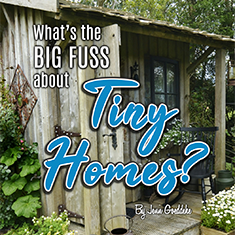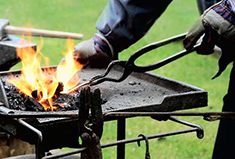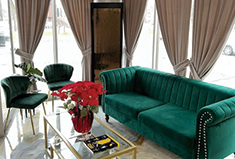What’s the BIG FUSS about Tiny Homes?
By Jenn Goeddeke
HOW DO YOU ENVISION YOUR DREAM LIFESTYLE? Many Americans live paycheck-to-paycheck, and wish to escape the cycle of debt, including steep mortgage payments.
 Increasing numbers of home buyers aim to downsize and simplify – to live with less. The cost of buying and maintaining a tiny home is far lower than fullsize homes. This equates to greater savings over time and thus more freedom to enjoy other life experiences. According to Darrin Roberts (of Jim Shaffer & Associates Realtors), “Many of my clients in the Ferndale area are looking for smaller and lower-maintenance homes, to create a simpler yet functional living space. They are innovative, creative individuals and want broader lifestyle experiences.”
Increasing numbers of home buyers aim to downsize and simplify – to live with less. The cost of buying and maintaining a tiny home is far lower than fullsize homes. This equates to greater savings over time and thus more freedom to enjoy other life experiences. According to Darrin Roberts (of Jim Shaffer & Associates Realtors), “Many of my clients in the Ferndale area are looking for smaller and lower-maintenance homes, to create a simpler yet functional living space. They are innovative, creative individuals and want broader lifestyle experiences.”
The Tiny House Movement essentially started in the 1970s. The outlook is a combination of lifestyle choice and philosophy plus typically an ecological attitude (green footprint/sustainability awareness). Often this is promoted in a dreamy or idealistic way. Early advocates included Lloyd Kahn, Shelter (1973), and Lester Walker, Tiny Houses (1987). Popular media coverage began around 2014 with the TV show Tiny House Nation.
Tiny homes have gradually become larger, heavier, and more expensive over the years (according to online resources). Different cities have reacted in various ways regarding zoning and coding, especially regarding accommodating the homeless communities. Some more progressive cities such as Oakland (California), Edinburgh (United Kingdom) and Detroit (Michigan) have embraced some possibilities using tiny homes as a partial solution.
 A local project certainly worth mentioning is the Tiny Homes Detroit project, formed by Cass Community Social Services. They developed 25 different homes on foundations, with 30×100 ft lots. The homes include front porches or rear decks. This is a rent-to-own situation developed for low-income individuals, including seniors; homeless individuals, and college students (see below for website reference link).
A local project certainly worth mentioning is the Tiny Homes Detroit project, formed by Cass Community Social Services. They developed 25 different homes on foundations, with 30×100 ft lots. The homes include front porches or rear decks. This is a rent-to-own situation developed for low-income individuals, including seniors; homeless individuals, and college students (see below for website reference link).
HOW BIG SHOULD IT BE? Technically, a tiny home has a maximum size of 500 square feet and most are just 100-400 sq/ft. However, in a broader sense, the term encompasses homes that are less than 900 sq/ft. The two basic types are those built either on a mobile platform of some kind or a permanent house foundation. Various considerations need to be made regarding each type. Planning is key!
Roberts added, “In the Ferndale area, many starter homes are between 580-700 sq/ft. Typically they include two bedrooms, one bath, a small kitchen, and a living area. They sell for around $125,000-150,000. First-time buyers or those on a limited budget often are interested in these smaller homes. Or these buyers might be looking for a second residence.”
 Tiny homes typically range from $10,000 to around $180,000, depending on the options/materials used. Building your own will cost around $25,000 but can be done for less.
Tiny homes typically range from $10,000 to around $180,000, depending on the options/materials used. Building your own will cost around $25,000 but can be done for less.
Living in a smaller space can encourage people to declutter and live more simply. Other positive benefits include: Easier to clean; cheaper to maintain and repair; lower energy bills/taxes and a greener footprint, plus an emphasis on creative design and a quality build.
Despite the restriction in size, owners can make the most of their vertical space options with things like a loft and upper deck.
INCLUDED IN THE TINY HOME LIFESTYLE IS AN INHERENT SENSE OF ADVENTURE. Plus the aesthetics are hugely important. They are designed in many eclectic ways, with various architectural influences including Modernism; Japanese; Rustic; Moroccan; Gothic, and so on. Other creative options include converting an existing structure e.g. a recreational vehicle or camper van.
 With so many choices, how can you decide which type is right for you? A good start might be creating a list of features you need and want. For example, are you looking for an ultragreen way of life? Or perhaps a unique, alternate vacation home in a scenic locale? Some helpful approaches to making your decision: Staying in a tiny house hotel, reading blogs, subscribing to podcasts or online groups, and talking to others who own one.
With so many choices, how can you decide which type is right for you? A good start might be creating a list of features you need and want. For example, are you looking for an ultragreen way of life? Or perhaps a unique, alternate vacation home in a scenic locale? Some helpful approaches to making your decision: Staying in a tiny house hotel, reading blogs, subscribing to podcasts or online groups, and talking to others who own one.
What are some of the hurdles in becoming a Tiny Homeowner? Finding a suitable location seems to be the most prominent challenge. During the planning phase, potential owners must look into local zoning and ordinance laws. Also, insurance and financing options require some research.
 The next phase will be attaining a building permit. If you are building a tiny home within Michigan, it is worth noting that the more established communities exist in these cities: Grand Rapids, Ann Arbor, Lansing, Kalamazoo, Traverse City, Dearborn, and Detroit. For some people looking for a downsized, alternative way of living, it may be easier to follow an RV lifestyle. There is a larger community who live full-time in their RVs and the regulations are more straightforward at this time.
The next phase will be attaining a building permit. If you are building a tiny home within Michigan, it is worth noting that the more established communities exist in these cities: Grand Rapids, Ann Arbor, Lansing, Kalamazoo, Traverse City, Dearborn, and Detroit. For some people looking for a downsized, alternative way of living, it may be easier to follow an RV lifestyle. There is a larger community who live full-time in their RVs and the regulations are more straightforward at this time.
TO SUMMARIZE, THERE IS A GREAT DEAL OF PLANNING involved In building your own tiny home. However, if you establish a suitable location and comply with local codes and ordinances, there is a good chance you can create a quality, customized masterpiece, eco-friendly and possibly portable, with plenty of aesthetic appeals without a huge expense. The choice is yours!
Jim Shaffer & Associates, Darrin Roberts, 616.403.5710
www.SoldCallJim.com;
www.casscommunity.org (Tiny Homes Detroit project);
www.manta.com (building cost calculator;
www.thespruce.com
www.treehugger.com
www.thetinylife.com
www.easygliderstorage.com



